©Damen,
2021
Classical Drama
and Theatre
Return to Chapters
SECTION 2: CLASSICAL GREEK TRAGEDY AND THEATRE
Chapter 7: Classical Greek Tragedy, Part 1
I. Introduction: The Data, or the Depressing Lack Thereof
Although Aeschylus, Sophocles, and Euripides emerge from history as the great
names associated with Greek tragedy, there were scores of other dramatists who
achieved renown over the course of classical antiquity. The triumphs of many
playwrights at the Dionysia are recorded in inscriptions and other sources.
In the end, it isn't clear why the works of only three tragedians have come
down to us—or why these three in particular—except that
subsequent generations put this trio in a class above their peers.
Despite so narrow a slice of history, occasionally a
glimpse of the larger pool of writing talent at work in the day drifts into
view, for instance, the drama of the late fifth-century tragedian Agathon.
While no play of his survives entire, several other Greek authors mention him,
including the philosophers Aristotle and Plato and the comic poet Aristophanes.
According to Aristotle (Poetics 9), for instance, Agathon "invented
plots," by which Aristotle appears to mean that he devised the first dramas based
on original storylines, that is, build around characters not taken from older myths
or tales. If so, Agathon's contribution was critical in the evolution of Western drama, at least inasmuch
as practitioners and viewers of the artform have long held the creation of new and innovative plots in high regard.
Moreover, in Plato's Symposium, a philosophical
treatise which takes place in Agathon's house during a party celebrating his first place-award for playwriting at the Dionysia of 416 BCE, Socrates praises the
beauty and subtlety of Agathon's verse. All of this makes it impossible not to regret
the loss of his work.
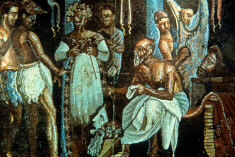 Worse
yet, even the dramatic output of the surviving trio is not particularly well
accounted for. From the hundreds of plays Aeschylus, Sophocles, and Euripides
composed, a mere thirty-three have been preserved whole, and of those only one
is a satyr play, Euripides' Cyclops, the sole representative of its
genre to have been transmitted in manuscript form to the modern age (see below,
Chapter 8). Ironically, Aeschylus was almost as well known in antiquity for his satyr
plays as for his tragedies, a reputation that endured for centuries. To wit, a Roman
mosaic created half a millennium after the Classical Age depicts Aeschylus directing
not a tragedy but a satyr play.
Worse
yet, even the dramatic output of the surviving trio is not particularly well
accounted for. From the hundreds of plays Aeschylus, Sophocles, and Euripides
composed, a mere thirty-three have been preserved whole, and of those only one
is a satyr play, Euripides' Cyclops, the sole representative of its
genre to have been transmitted in manuscript form to the modern age (see below,
Chapter 8). Ironically, Aeschylus was almost as well known in antiquity for his satyr
plays as for his tragedies, a reputation that endured for centuries. To wit, a Roman
mosaic created half a millennium after the Classical Age depicts Aeschylus directing
not a tragedy but a satyr play.
Likewise, the Roman poet Horace mentions Aristophanes in the same breath with two of his fellow comic playwrights, Eupolis and Cratinus, which suggests he held all three in relatively equal esteem. Today, however,
only Aristophanes has works that survive whole. This litany of loss serves as a stern reminder that our picture of classical drama is far from complete, making it difficult to understand critical aspects of the theatre in the period when it first flourished.
II. Early (Pre-Aeschylean) Tragedy
Little is known about specific Greek tragedies
prior to Aeschylus. While fragments of text and the occasional anecdote may
shed a ray of light here and there, all but nothing can be confirmed from credible
historical sources. Our best information about early drama comes, in fact, not
from plays as such but from inscriptions, often official notices
put up by the Athenian state. This type of evidence is called epigraphical
("written on") because the records were carved onto stone plaques,
usually marble, and posted in public places.
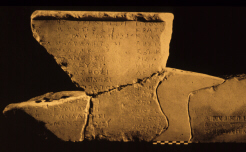 For
drama, the most informative of these inscriptions are the Athenian victory
lists, a year-by-year catalogue of the playwrights and producers—and later, performers—who
won first prize at the City Dionysia. From these lists not only emerge
many names of Greek playwrights and choregoi who would otherwise have
passed from memory entirely, but these inscriptions also shed light on the evolution
of theatre and drama in ancient Athens. For instance, the victory lists document
the rise of actors by indicating the period when they began to be awarded prizes.
For
drama, the most informative of these inscriptions are the Athenian victory
lists, a year-by-year catalogue of the playwrights and producers—and later, performers—who
won first prize at the City Dionysia. From these lists not only emerge
many names of Greek playwrights and choregoi who would otherwise have
passed from memory entirely, but these inscriptions also shed light on the evolution
of theatre and drama in ancient Athens. For instance, the victory lists document
the rise of actors by indicating the period when they began to be awarded prizes.
Also, because a playwright's name was carved on the list the first time he
won the competition, but if he succeeded again, his name was not inscribed a
second time—instead, a tick mark was added next to his name—the victory
lists provide a relative chronology of when winning playwrights first made their mark in the theatre. If these accounts
were complete, the information given there would be among the best primary
evidence available for drama in the Classical Age. Unfortunately, they are
not.
Another epigraphical source providing
important information about fifth-century theatre is the Parian Marble.
This monumental inscription—it is six feet, seven inches high, and two
feet, three inches wide—was found on the Aegean island of Paros, hence
its name. Its text is a purported history of Greece, but it focuses mainly on
Athens with a clear bias toward glorifying the city and its inhabitants. Though it dates to well after the Classical Age—it was inscribed around 275 BCE—much of the information cited on it is corroborated elsewhere and so in general it seems
fairly reliable. (note) Because Athens
was by then widely recognized as the "birthplace of theatre," it often
addresses drama, and in particular tragedy, along with the lives and careers of the principal
playwrights who lived during the Classical Age.
Given such data, we can piece together a rough outline
of the course of early fifth-century tragedy. One of the first playwrights to
appear in the historical record is Choerilus, who is, in fact, little
more than a name to which but one play title has been attached (Alope).
About Pratinas, another playwright of roughly the same period,
all that is known is that he composed both tragedies and satyr plays (see Chapter
8). Standing somewhat closer to the horizon of our knowledge, Phrynichus
is mentioned in Herodotus' Histories (6.21) for "causing too much
grief" to the Athenians when he staged a tragedy entitled The
Siege of Miletus. This play deserves mention if for nothing else
than that it is the first Western drama for which there exists specific information
about the production. For instance, its subject revolved around recent history,
not myth, making it also the earliest known historical drama.
We know more about another of Phrynichus'
tragedies, The Phoenician Women, a play which was
set in the Near East around the end of the Second Persian War (479 BCE).
This tragedy, no doubt, focused on the sorrows of the defeated Persians but
was staged, according to one source, in a remarkably modern manner. If our source
can be trusted, the play opened with a servant relating to the audience the
recent defeat of the Persians as he went around the stage arranging chairs for
nobles at a council meeting. (note) Two
decades later, Aeschylus employed the same sort of device in one of his plays, Agamemnon,
which also begins with a servant, in this case a Watchman, waiting for his master
to return home from Troy, and just like in Phrynichus' play, this character lays out the background of the plot for the audience at the
outset of the drama.
In other ways, too, Phrynichus seems to have
laid the groundwork for tragedy's rise to greatness. One source claims he was
the first dramatist to introduce female characters onto the stage but, as such,
that is hard to believe because tragedy had been up and going for at least two
generations by Phrynichus' day. It seems unlikely, if not impossible, for all
those early tragedians to have restricted themselves to presenting only male
characters in their plays. Nor is there any real reason that they should have.
There would have been little pressure on male performers in ancient Greece to
refrain from portraying women on stage, since, as far back in Greek poetry as
Homer, poets were quoting female characters' words in performance. More likely, Phrynichus was the first playwright to focus
on female characters, which would in this case tie him to Euripides who wrote in the next generation and was
known for creating memorable stage women.
All in all, Phrynichus was admired and imitated for at least two generations
after his lifetime. (note) But like Philip
II of Macedon whose glory was later eclipsed by his successor (and son), Alexander
the Great, Phrynichus' fame was overshadowed by the man who assumed his
mantle as the pre-eminent playwright of Athens in the next generation. That
man was, of course, Aeschylus.
III. Aeschylus (ca. 525-456 BCE)
A. Aeschylus' Life and Career
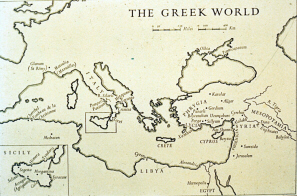 We
know much more about Aeschylus than his predecessors, due,
no doubt, to his subsequent renown as a poet and dramatist. Aeschylus was
born around 525/524 BCE and died in 456 BCE. Though not among the rich, he came
from good Athenian stock and was apparently well-educated. Aeschylus
fought both at the Battle of Marathon in the First Persian War, a detail preserved
on the Parian Marble, and again at the Battle of Salamis
during the Second Persian War, when he, by then in his forties,
rowed with the Greek navy as it defeated the Persians in 480 BCE. (note) His brother Cynegirus is reported to have died there.
Aeschylus' participation
in this battle finds its best confirmation in his own play entitled Persae ("The Persians"), a tragedy
that narrates the events that happened at sea that day and pays close attention
to the sorts of details a sailor, as opposed to a general, would have noted.
We
know much more about Aeschylus than his predecessors, due,
no doubt, to his subsequent renown as a poet and dramatist. Aeschylus was
born around 525/524 BCE and died in 456 BCE. Though not among the rich, he came
from good Athenian stock and was apparently well-educated. Aeschylus
fought both at the Battle of Marathon in the First Persian War, a detail preserved
on the Parian Marble, and again at the Battle of Salamis
during the Second Persian War, when he, by then in his forties,
rowed with the Greek navy as it defeated the Persians in 480 BCE. (note) His brother Cynegirus is reported to have died there.
Aeschylus' participation
in this battle finds its best confirmation in his own play entitled Persae ("The Persians"), a tragedy
that narrates the events that happened at sea that day and pays close attention
to the sorts of details a sailor, as opposed to a general, would have noted.
Aeschylus is said to have died in Sicily,
presumably on tour since we are told that the Greeks who lived there admired his work. Confirmation of this comes from the title of one of his
tragedies, The Women of Etna, which appears to have been written primarily
for a Sicilian viewership. (note) If so,
it constitutes one of the few instances that we know of drama
being performed outside the City Dionysia in Athens during the fifth century
BCE.
All evidence indicates that, beginning at least in the later part of his career,
the ancients held Aeschylus' work in high esteem. This is confirmed by the number of times he won first prize at the Dionysia—his biography says
thirteen—along with the praise showered on him after his lifetime. To wit,
a decree issued by the Athenians several decades after Aeschylus' life attests
to his enduring popularity throughout the Classical Age. It proclaimed that,
if anyone wished to revive one of Aeschylus' plays, the city itself would act
as choregos and pay for the chorus,
by far the costliest aspect of theatre production in that day.
But things are not that simple. His rise to prominence does not appear to have been quick or easy. For instance, the Parian Marble reports that Aeschylus' first victory at
the Dionysia came only in 484 BCE, fairly late in his career, which is certainly not the first time he entered the Dionysia. To judge from the number
of extant play titles credited to him—he wrote at least seventy dramas
constituting a minimum of seventeen separate tetralogies (three tragedies plus
a satyr play)—Aeschylus' career had to have begun earlier
than 484 BCE because it would have been infeasible for him to enter the competition
at the Dionysia often enough between 484 and his death in 456 to generate that
many plays. Thus, for at least some portion of his early career he must have
gone without the recognition that winning at the Dionysia conferred.
B. Aeschylean Drama
The reason for such a rough road to success but also his enduring presence
on the Athenian stage centered, no doubt, around his well-documented ingenuity
as a poet, playwright and technician of theatre. A great experimenter with all
aspects of drama, Aeschylus was renowned for creating spectacular effects on
stage. In the middle of his play The Suppliants, for example, he has
a second chorus of men rush onto the stage and attempt to abduct the principal
chorus consisting of female characters. Our text today records only cries and shrieks—it reads
literally "o! o! o! a! a! a!" (Supp. 825)—but
this moment must have been very exciting to watch with so many actors running
around and yelling, as if a battle were taking place on stage. It surely also taxed the producer's purse, but then the trade-off for backing a winning Aeschylean
spectacle and having one's name inscribed on the victory lists must have been
very tempting, too.
To judge from his extant plays, Aeschylus also
enjoyed creating and solving dramatic challenges. For instance, the central and title character in Prometheus
Bound, the rebellious titan who
in Greek myth betrays the gods and brings fire down to humankind, is nailed to a rock in the first
scene of the play and never moves from that spot until the end of the show. (note) Leave
it to Aeschylus to conceive of a drama in which the hero does not—nay, cannot!—walk around. His reason for choosing a tale like this is not
as easy to pin down as its title character, however. Perhaps he wanted more
time to work with the chorus and execute innovative dances and songs for them,
so he froze the leading actor (himself?) centerstage. It would certainly have
saved him a considerable amount of time blocking the show.
Aeschylus was also famous for his "silent" characters like Cassandra
in Agamemnon, as we noted in the
previous chapter. Given a theatrical milieu in which there is a convention
of mute (as opposed to "speaking") actors, coupled with multiple role-playing,
Aeschylus more than once has fun with his audience's anticipation of whether
a character will speak. In other words, he has turned a convention that might
be seen as a limitation in the eyes of less talented artists into an opportunity
to generate dramatic tension by finding a novel and intriguing way of engaging
the audience's interest. Such bold finesse is not inappropriate for the man
whom Aristotle credits with having "invented" dialogue.
The earliest drama we have by Aeschylus is Persae, which was mentioned above, a play produced in 472 BCE with none other than the young
Pericles as choregos. Based
on recent history, it stands out as the only Greek tragedy extant which does
not take its subject matter from myth. It focuses, instead, on the Persians'
reaction to their defeat at the hands of the Greeks in the Second Persian War (481-479 BCE),
an event still fresh in the minds of many in Aeschylus' audience, some of whom
would have been veterans of that campaign. As such, the play owes a clear debt
to Phrynichus' The Phoenician Women and in more ways than one looks
backward as much as forward. It is a bold and creative play, nevertheless, but nothing
as audacious as Aeschylus would go on to produce in the last years of his life,
and so though he was around fifty-years-old when he composed Persae,
it seems safe to say he had clearly not yet hit his stride.
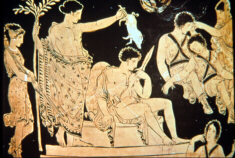 Indeed,
Aeschylus' consummate work is among his last, the trilogy he wrote about the
family of Agamemnon, The Oresteia. Produced in 458
BCE, just two years before the playwright's death, the three plays of this trilogy
(Agamemnon, The Libation-Bearers, The Eumenides)
represent the only true trilogy extant from the Classical Age. That is, the
Oresteia is the one surviving instance of three tragedies which were
originally designed to be performed together at the Dionysia. While other so-called
"trilogies," such as Sophocles' "Theban trilogy" (Oedipus,
Oedipus at Colonus, Antigone), may today appear to constitute
a trilogy, in actuality the playwright did not originally compose these plays
for performance at the same festival but instead on different occasions over
the course of thirty years. The joining together of this triad of plays into a "trilogy"
is the result of modern conflation.
Indeed,
Aeschylus' consummate work is among his last, the trilogy he wrote about the
family of Agamemnon, The Oresteia. Produced in 458
BCE, just two years before the playwright's death, the three plays of this trilogy
(Agamemnon, The Libation-Bearers, The Eumenides)
represent the only true trilogy extant from the Classical Age. That is, the
Oresteia is the one surviving instance of three tragedies which were
originally designed to be performed together at the Dionysia. While other so-called
"trilogies," such as Sophocles' "Theban trilogy" (Oedipus,
Oedipus at Colonus, Antigone), may today appear to constitute
a trilogy, in actuality the playwright did not originally compose these plays
for performance at the same festival but instead on different occasions over
the course of thirty years. The joining together of this triad of plays into a "trilogy"
is the result of modern conflation.
The Oresteia begins with the general Agamemnon's return to Greece,
having just won the Trojan War (click
here for a fuller version of the myth on which this trilogy is based). In
the first play, Agamemnon, the title character meets his wife Clytemnestra
after a ten-year absence and almost immediately upon his arrival she murders
him in revenge for his sacrifice of their daughter Iphigenia when he left for
the war a decade earlier. In the second play, The Libation-Bearers,
which takes place several years later, Agamemnon's son Orestes who has been
raised in a faraway land arrives in Argos and, with the encouragement of his
sister Electra, kills their mother Clytemnestra.
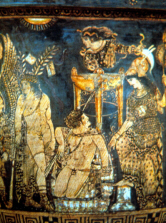 The
concluding play, The Eumenides, tells how Clytemnestra's
Furies—referred to euphemistically as Eumenides ("good-minded ones")
when they are, in fact, hell-sent demons of vengeance—rise from
the bowels of the earth and pursue Orestes demanding recompense for Clytemnestra's
murder. Orestes flees to Athens where the gods put him on trial for murder.
With Apollo acting as his defense attorney and Athena as judge, Orestes wins
acquittal, but only through a crafty bit of legal chicanery. At the end of the play, Athena assuages the Furies' wrath by making them "honorary citizens"
of Athen—the ancient term is "metic," a resident foreigner allowed to live in Athens—and agrees to have her people, the Athenians, celebrate
the Furies in ritual, an actual ceremony in Aeschylus' day. The finale of The
Eumenides contains features typical of Aeschylean grandeur, as the chorus
of Furies turn the stygian black cloaks of their costumes inside out to reveal a scarlet inner
lining. In Aeschylus' day, Athenian metics wore scarlet capes in formal
processions. With this grand gesture, a stroke of high drama, Aeschylus
creates a bold theatrical vision of peace and divine justice bestowed upon a deserving land for its merciful treatment of the wrongly accused.
The
concluding play, The Eumenides, tells how Clytemnestra's
Furies—referred to euphemistically as Eumenides ("good-minded ones")
when they are, in fact, hell-sent demons of vengeance—rise from
the bowels of the earth and pursue Orestes demanding recompense for Clytemnestra's
murder. Orestes flees to Athens where the gods put him on trial for murder.
With Apollo acting as his defense attorney and Athena as judge, Orestes wins
acquittal, but only through a crafty bit of legal chicanery. At the end of the play, Athena assuages the Furies' wrath by making them "honorary citizens"
of Athen—the ancient term is "metic," a resident foreigner allowed to live in Athens—and agrees to have her people, the Athenians, celebrate
the Furies in ritual, an actual ceremony in Aeschylus' day. The finale of The
Eumenides contains features typical of Aeschylean grandeur, as the chorus
of Furies turn the stygian black cloaks of their costumes inside out to reveal a scarlet inner
lining. In Aeschylus' day, Athenian metics wore scarlet capes in formal
processions. With this grand gesture, a stroke of high drama, Aeschylus
creates a bold theatrical vision of peace and divine justice bestowed upon a deserving land for its merciful treatment of the wrongly accused.
Aeschylus' writing style is hardly less daring than his stagecraft.
In its lofty elegance, it attains the same profundity as Shakespeare's English. They also rival each other in incomprehensibility at times. Even
to the ancient Greeks some of Aeschylus' poetry seemed so unfathomable that
rumor had it he composed his plays drunk. It was unimaginable to them that a sober person
could concoct such fantastical turns of phrase.
For instance, when the chorus in Agamemnon describes the title character's
sacrifice of his own daughter Iphigenia, Aeschylus has them speak of "staining
fatherly hands with virgin-slaughtered streams of blood" (Ag.
209-210). More extreme still, near the end of the same play, after Clytemnestra
has stabbed her husband to death, Aeschylus brings her on stage standing in triumph over the dead Agamemnon. Towering above his blood-soaked
corpse, she holds aloft the knife she used to butcher him and claims her long-awaited
vengeance, pay-back for her daughter's sacrifice, and boldly narrates how she
committed the murder (Ag. 1382-92; translated literally from the Greek):
An endless cloak, as if for fishes,
I put around him, a wealthy weight of fabric, evil;
I strike him twice, and with two groans
He relaxes his limbs, and once he fell,
A third blow I dedicate, to the Zeus of Hell,
Savior of the dead, a prayerful gift of thanks.
So his spirit he exhales, after he went down,
And blowing out a bitter blood-slaughter
Hits me with a murky drop of gory dew,
And I rejoice no less than with god-given
Delight in the seeded pod's birth.
In other words, Clytemnestra exults in her husband's slaughter as it were the coming of spring with blossoms bursting into fruit. To her, his destruction
is her rebirth, his murder her bounty, his blood her fertility. For one miraculous moment, life is death,
as this remorseless murderess revels in her victim's demise with
no sense of guilt whatsoever at being caught literally red-handed in the act.
According to ancient sources, the aged Aeschylus died when
an eagle, carrying a turtle aloft so it could drop it on a rock and crush its
shell, saw the elderly Aeschylus' bald head and unloaded the poor creature on
him, killing him and presumably the turtle as well. Such fanciful stories
accreted naturally around the great tragedians and point, if not to any literal
truth, to the abiding popularity and pre-eminence of classical drama in the
ancient world. At the same time, however, with only a handful of complete plays by
Aeschylus surviving to our day, it's clear how difficult were the straits his
works had to pass through after antiquity, brutal times filled with bibliophagic
Scyllas that devoured many of their companions. In Chapter 7.3, we will see why there are so few of Aeschylus' plays extant, but first we must look at the work of his great dramatic heir—and briefly also his most important rival—Sophocles.
Terms, Places, People and Things to Know
|
Agathon [AGG-uh-thonn]
Symposium [simm-POSE-see-um]
Inscriptions
Epigraphical
Athenian Victory Lists
Parian Marble [PAIR-ree-un]
Choerilus [KOY-rill-us]
Pratinas [pruh-TINE-us]
Phrynichus [FRINE-nick-uss]
The Siege of Miletus [my-LEE-tuss]
|
The Phoenician Women
Aeschylus [EE-skull-us; also ESS-skull-us]
Sicily
Prometheus Bound
Persae [PAIR-sigh]
The Oresteia [oar-ress-TIE-uh]
Clytemnestra
The Libation-Bearers
The Eumenides [you-MEN-uh-dees]
|
This work is licensed under a Creative Commons Attribution-NonCommercial-ShareAlike 4.0 International License.
 Worse
yet, even the dramatic output of the surviving trio is not particularly well
accounted for. From the hundreds of plays Aeschylus, Sophocles, and Euripides
composed, a mere thirty-three have been preserved whole, and of those only one
is a satyr play, Euripides' Cyclops, the sole representative of its
genre to have been transmitted in manuscript form to the modern age (see below,
Chapter 8). Ironically, Aeschylus was almost as well known in antiquity for his satyr
plays as for his tragedies, a reputation that endured for centuries. To wit, a Roman
mosaic created half a millennium after the Classical Age depicts Aeschylus directing
not a tragedy but a satyr play.
Worse
yet, even the dramatic output of the surviving trio is not particularly well
accounted for. From the hundreds of plays Aeschylus, Sophocles, and Euripides
composed, a mere thirty-three have been preserved whole, and of those only one
is a satyr play, Euripides' Cyclops, the sole representative of its
genre to have been transmitted in manuscript form to the modern age (see below,
Chapter 8). Ironically, Aeschylus was almost as well known in antiquity for his satyr
plays as for his tragedies, a reputation that endured for centuries. To wit, a Roman
mosaic created half a millennium after the Classical Age depicts Aeschylus directing
not a tragedy but a satyr play. 


